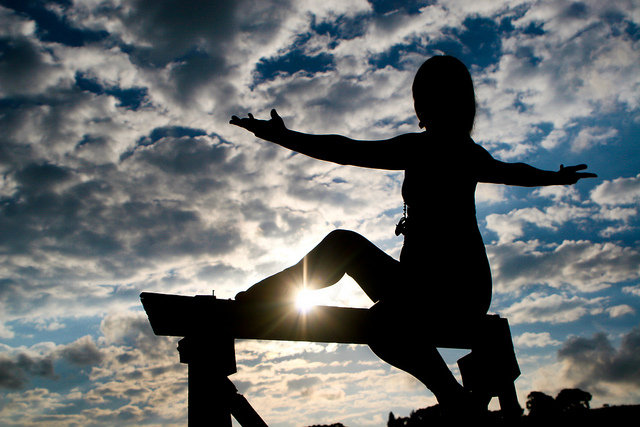I’ve been teaching yoga for a long(ish) time—about three or four years.
Throughout this time, I’ve taught the same classes—basic yoga and Yin, three nights a week, plus private sessions and subbing.
And sometimes—because I’m a human as well as a yoga teacher—I get in a rut.
Of course, there are specific times when being “in a groove” is good. In one of my basic classes, we’re working our way toward a lovely Parivrtta Utkatasana—”Revolved Chair” Pose. I’m talking “put your right hand down next to your left foot” revolved. So it takes some serious preparation, particularly for those students who only attend one class a week.
I have a template for a sequence that I mix and match with the aim of getting them, over the next few weeks, to “put your right hand down next to your left foot” when they’re in Utkatasana. We’re getting there, little by little, and it’ll be joyful when we do arrive.
However, sometimes—I walk into class thinking, “Man, I really need a bolt of inspiration here.”
Sometimes, the Universe steps in and helps me out, but sometimes, frankly—I’m left hanging.
Let’s be realistic, the casual yoga student isn’t likely to remember if we teach the same sequence over and over—as long as we simply reverse the order of a few poses or change the arms in all the Warrior Poses.
However, the students who are on the cusp of “getting it” the way you do, or those who’ve already gotten to and past that point? They notice. And if you have excellent students, they’ll realize that off the mat (and on the mat), you are simply as human as they are. It happens to everyone.
Recharging can be as simple as taking a class.
My favorite thing is to take a class with the person who started as my teacher and is now my dear friend. We can take a class together, and then dissect it in terms of how to apply it to students we teach.
Since she teaches a lot of private lessons and her public classes are mainly seniors, she looks at it through that lens. Since I’m also teaching privates, but my public classes don’t focus on seniors, I can ask for her wisdom when I think that something might work. I appreciate the dialogue, and sometimes that’s enough to get my yoga “mojo” going again.
Other times, I’ll sit down with my training manual. I look at poses that I haven’t done since training, and consider if I can either work them into a class or modify them (for instance, Dolphin instead of a forearm stand) for use with my students.
And there are books. I rarely go online, truthfully. There’s too much to wade through, and I’m a bookish sort who loves to page through and see where the book takes me.
Bernie Clark has helped me revive a couple of my Yin classes recently. After his priceless commentary on Happy Baby Pose, my class was laughing, relaxed and feeling good about themselves and their yoga.
Bernie says, “This posture is the single most important reason that video recording equipment and cameras are not allowed in yoga studios.” (p. 104, The Complete Guide to Yin Yoga)
Anything from Ray Long or Sarah Powers reminds me of the beauty of the human body.
Our job, as yoga teachers, is to see that beauty in every student who shows up in our classes.
That beauty can be seen—if we have eyes and a soul—when a student who’s been struggling with Trikonasana, finally gets her top arm in correct alignment (after I’ve adjusted her habit of throwing her shoulder back, for what seems to be the zillionth time—in my mind and hers).
But when she does it herself—we see the beauty in her physical form and in her heart.
I can’t look at images of “perfect” yogis and yoginis. Even looking at Light on Yoga intimidates me, because I know I’ll never do a perfect Padmanasana.—my knees aren’t built that way, nor are my hips. But, I can trust BKS Iyengar’s timeless wisdom, take some instruction from his teachings about the benefits of the poses and share those teachings with my students.
I can watch my students’ eyes light up when they get, not only the physical form of Virabhadrasana III, but also the mental confidence that they are indeed a warrior. That they have strength, not only in their legs and their torso, but also in their mind—to focus on the breath, the lengthening of the body and on the internal work it takes to make that pose what it is for them.
Burn-out is real.
Teaching private lessons and public classes and holding a “regular” full-time job? It’s wearing, people!
But ultimately, it’s in my own best interest to not only keep my personal practice alive and well, but to keep myself focused on why I love teaching—I love the evolution of my students.
When I see my “basic yoga” students happily partaking of advanced poses in the other classes my studio offers, my heart is bursting. Because they built that confidence, and I know I helped them get there.
I find that the more my students want from my classes, the more I want to give.
So while I do watch myself—and try to not keep defaulting to that “same-old, same-old” sequence, because it’s Monday night and I’m tired—I also take heart that I’m not alone in this feeling.
Teachers before me have dealt with this—and teachers after me will continue to also.
It’s my well—and it’s my job to make sure that the water in my well is always refreshed and refreshing!
.
Relephant:
There Are No Assigned Seats in Yoga: How to Get Out of a Yoga Rut.
.
Author: Pat Perrier
Editor: Yoli Ramazzina









Read 4 comments and reply